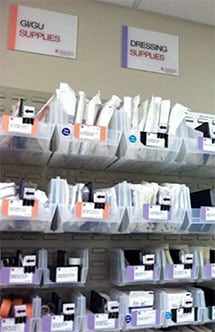Hospital Improves Patient Care Through New Supply Chain Practices

Can a medical supply room reorganization significantly affect patient outcomes? The University of Chicago Medicine thinks so. That idea was the focus of a major initiative to improve the academic medical center’s supply chain practices, and boost each supply area’s impact on patient safety and quality of care.
UChicago Medicine’s Challenge
In 2011, UChicago Medicine’s supply chain team assessed the daily process of staff members locating the correct medical supplies and understood getting back to the patient in the quickest time possible is of the utmost importance – and one of the medical system’s greatest supply challenges. With nearly 150 nursing supply rooms throughout the medical campus, team members worked with nursing and other clinical staff to standardize room layout and implement best practices to ensure appropriate product organization and supply labeling. The team also worked to comply with all safety standards, reduce waste, and – most importantly – have the right product in the right place at the right time.
Common supply room issues identified by the UChicago Medicine team included excess stock, stock-outs, and multiple types of items in bins, items hanging from carts, and items placed haphazardly on the top of shelving units.
An Improved Storage System
Initial actions taken for UChicago Medicine’s program included supply room organization and standardization using Lean 5S techniques (sort, set, shine, standardize, sustain), and bin “right-sizing” to maximize existing space and minimize overstocking. Instrumental to this plan are industry-leading storage and organization products from Akro-Mils – including Beige Louvered Panels and Racks (providing high-density storage), Clear AkroBins® (for item visibility), Easy Flow Gravity Hoppers (for first-in-first-out item lot rotation), and Rail Hanging Systems and Shelving Systems (for additional storage options).
The benefits of using Akro-Mils products became apparent to UChicago Medicine’s supply chain as they used different products to solve unique challenges in specific areas, says Julie Aggen, Senior Process Transformation Specialist at the medical center.
One of the benefits of implementing a Kanban Stock Replenishment System is having a built-in stock rotation function,” she explains. “Bins with dividers worked great for our process until we were challenged with the rotation of extremely high-volume items in the Emergency Department’s supply room. It just wasn’t practical for this area. But the Akro-Mils Rail Hanging System was the answer to that challenge.
“Rather than moving large amounts of product from one bin to another, we were able to simply slide the empty bins off the rail, push over the bins still containing product, and slide the empty ones back on the rail for restock,” she adds. “No lifting heavy bins full of product and no transferring large amounts of product from bin to bin. Best of all, stock is rotated quickly and efficiently.”
In addition to Akro-Mils products, UChicago Medicine implemented RFID technology to manage the reorder process, a Just-In-Time replenishment system, and color-coded Kanban cards that fit in the card holder on the front of the bin.

Better Costs and Quality of Care
Efficiencies created by the new program have been impressive, hospital officials say.
- Reduced waste: Unneeded products were removed from supply areas including general stores,
nursing units, procedural areas and operating rooms. - Reduced inventory: Overstock returned from supply areas has totaled $37,000, and clinicians
identified hundreds of items in the supply areas that were no longer needed.
Most importantly, UChicago Medicine clinicians and nursing staff are now spending less time looking for supplies, and in turn, gaining more time to care for their patients.
Aggen adds the supply area reorganization led to a noticeable increase in open floor space and an easy-to-maintain storage environment. “We are very pleased by these results, as patient safety and quality of care are our primary concerns,” she says.
